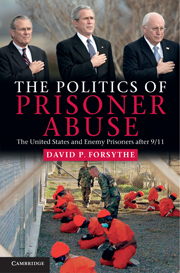Book contents
- Frontmatter
- Contents
- Preface
- List of abbreviations and acronyms
- 1 Torture and political morality in historical perspective
- 2 Political morality and the Bush Administration
- 3 Bush lawyers: the politics of legal interpretation
- 4 The military: Afghanistan, Guantánamo, Iraq
- 5 The CIA: kidnapping, Black Sites, extraordinary rendition
- 6 Due process: detention classification, Military Commissions
- 7 Prisoner abuse and the politics of transitional justice
- Annex A Cast of principal characters
- Annex B Reports on US policy toward enemy prisoners
- Annex C Some relevant legal norms: selected provisions
- Annex D Timeline, selected events, Bush Administration
- Index
Annex D - Timeline, selected events, Bush Administration
Published online by Cambridge University Press: 05 June 2012
- Frontmatter
- Contents
- Preface
- List of abbreviations and acronyms
- 1 Torture and political morality in historical perspective
- 2 Political morality and the Bush Administration
- 3 Bush lawyers: the politics of legal interpretation
- 4 The military: Afghanistan, Guantánamo, Iraq
- 5 The CIA: kidnapping, Black Sites, extraordinary rendition
- 6 Due process: detention classification, Military Commissions
- 7 Prisoner abuse and the politics of transitional justice
- Annex A Cast of principal characters
- Annex B Reports on US policy toward enemy prisoners
- Annex C Some relevant legal norms: selected provisions
- Annex D Timeline, selected events, Bush Administration
- Index
Summary
2001
9/11 Al-Qaeda attacks on New York and Washington. Almost 3,000 persons killed, mostly civilians.
9/14 President Bush declares state of national emergency; Congress passes Authorization to Use Military Force (AUMF) in response to attacks; general, vague authorization for Executive to take broad but unspecified actions.
9/16 Vice President Cheney gives interview about “going to the dark side,” United States having to use all means to respond to terrorism.
9/17 President Bush authorizes CIA to act against Al-Qaeda and its supporters, including secret detention.
9/25 Attorney John Yoo of DOJ sends memo to attorney Tim Flanigan in the White House saying President has unlimited authority to act for national security. President said not to be restrained by treaties or statutes.
10/7 United States launches armed attacks in Afghanistan.
11/6 DOJ attorneys provide memo saying 1949 Geneva Conventions do not apply to Taliban and Al-Qaeda prisoners in Afghanistan; Bush Administration reverses early decisions by military commanders in favor of laws of war and prisoners of war; broad pattern of abuse of prisoners follows in Kandahar, Bagram, and elsewhere, both by military and CIA. DOJ view eventually rejected by Supreme Court.
11/9 William Haynes, top civilian lawyer in the Pentagon, moves to establish system of Military Commissions to provide justice to enemy prisoners; minimizes concerns by military lawyers (JAGs).
- Type
- Chapter
- Information
- The Politics of Prisoner AbuseThe United States and Enemy Prisoners after 9/11, pp. 291 - 298Publisher: Cambridge University PressPrint publication year: 2011

